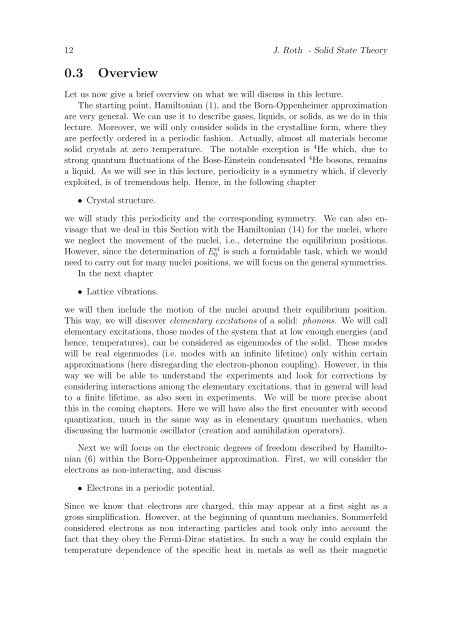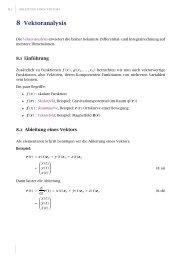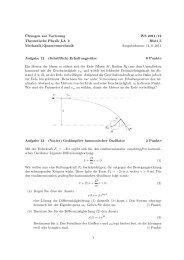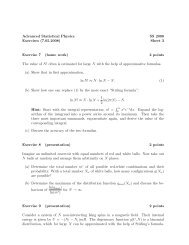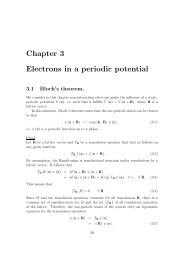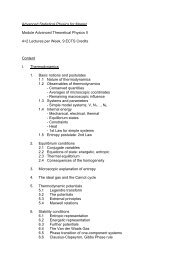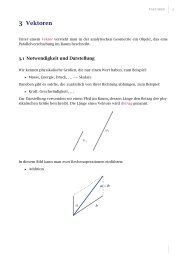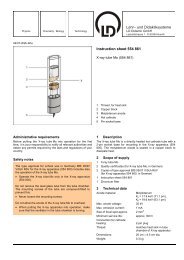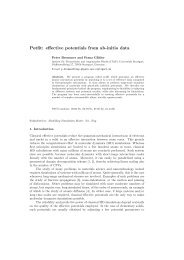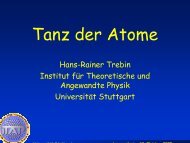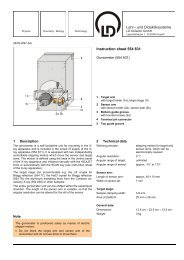Solid State Theory - Institut für Theoretische und Angewandte Physik ...
Solid State Theory - Institut für Theoretische und Angewandte Physik ...
Solid State Theory - Institut für Theoretische und Angewandte Physik ...
You also want an ePaper? Increase the reach of your titles
YUMPU automatically turns print PDFs into web optimized ePapers that Google loves.
12 J. Roth - <strong>Solid</strong> <strong>State</strong> <strong>Theory</strong>0.3 OverviewLet us now give a brief overview on what we will discuss in this lecture.The starting point, Hamiltonian (1), and the Born-Oppenheimer approximationare very general. We can use it to describe gases, liquids, or solids, as we do in thislecture. Moreover, we will only consider solids in the crystalline form, where theyare perfectly ordered in a periodic fashion. Actually, almost all materials becomesolid crystals at zero temperature. The notable exception is 4 He which, due tostrong quantum fluctuations of the Bose-Einstein condensated 4 He bosons, remainsa liquid. As we will see in this lecture, periodicity is a symmetry which, if cleverlyexploited, is of tremendous help. Hence, in the following chapter• Crystal structure.we will study this periodicity and the corresponding symmetry. We can also envisagethat we deal in this Section with the Hamiltonian (14) for the nuclei, wherewe neglect the movement of the nuclei, i.e., determine the equilibrium positions.However, since the determination of E0 el is such a formidable task, which we wouldneed to carry out for many nuclei positions, we will focus on the general symmetries.In the next chapter• Lattice vibrations.we will then include the motion of the nuclei aro<strong>und</strong> their equilibrium position.This way, we will discover elementary excitations of a solid: phonons. We will callelementary excitations, those modes of the system that at low enough energies (andhence, temperatures), can be considered as eigenmodes of the solid. These modeswill be real eigenmodes (i.e. modes with an infinite lifetime) only within certainapproximations (here disregarding the electron-phonon coupling). However, in thisway we will be able to <strong>und</strong>erstand the experiments and look for corrections byconsidering interactions among the elementary excitations, that in general will leadto a finite lifetime, as also seen in experiments. We will be more precise aboutthis in the coming chapters. Here we will have also the first encounter with secondquantization, much in the same way as in elementary quantum mechanics, whendiscussing the harmonic oscillator (creation and annihilation operators).Next we will focus on the electronic degrees of freedom described by Hamiltonian(6) within the Born-Oppenheimer approximation. First, we will consider theelectrons as non-interacting, and discuss• Electrons in a periodic potential.Since we know that electrons are charged, this may appear at a first sight as agross simplification. However, at the beginning of quantum mechanics, Sommerfeldconsidered electrons as non interacting particles and took only into account thefact that they obey the Fermi-Dirac statistics. In such a way he could explain thetemperature dependence of the specific heat in metals as well as their magnetic


